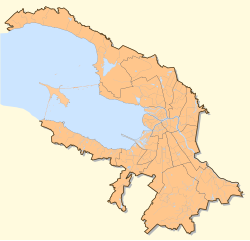Saint Petersburg is a city and a federal subject located in the Northwestern Federal District of Russia. It stands at the mouth of the Neva River at the east end of the Gulf of Finland (part of the Baltic Sea).



The area of the city of Saint Petersburg proper is 605.8 km2 (233.9 sq mi). As a federal subject Saint Petersburg contains, besides Saint Petersburg proper, a number of towns (Kolpino, Krasnoye Selo, Kronstadt, Lomonosov, Pavlovsk, Petergof, Pushkin, Sestroretsk and Zelenogorsk), 21 municipal settlements, as well as rural localities. The total territory of the federal subject as of 2015[update] comprises 1439 km2.
The federal subject and city of Saint Petersburg is situated on the middle taiga lowlands along the shores of the Neva Bay of the Gulf of Finland, along the shores of the lower reaches of the River Neva itself and on the numerous islands of the river delta.
To the north of the city lies the Karelian Isthmus, a popular summer-resort area for citizens, while in the south Saint Petersburg crosses the Baltic-Ladoga Klint and meets the Izhora Plateau.
The elevation of Saint Petersburg ranges from the sea level to its highest point of 175.9 m (577 ft) at the Orehovaya hill in the Duderhof Heights in the south. However, the historical city center (except the area between Liteyny Prospekt and Smolnaya Embankment) is situated lower than 4 metres (13 ft) above sea level and has suffered from flooding about 300 times in its history. Floods in Saint Petersburg are triggered by long waves in the Baltic Sea, developing regularly under some meteorological conditions and amplified by favorable winds and by the shallowness of the Neva Bay. The most disastrous floods occurred in 1824 (4.21 m, 13 ft 10 in above sea level[1]), 1924 (3.80 m, 12 ft 6 in), 1777 (3.21 m, 10 ft 6 in), 1955 (2.93 m, 9 ft 7 in) and 1975 (2.81 m, 9 ft 3 in). The Saint Petersburg Dam, built to prevent floods, was completed in August 2011 after a lengthy period of construction beginning in 1979.[2]
Since the 18th century the terrain in the city centre has been steadily raised artificially, at some places by more than 4 metres (13 ft). The hydrology of the city center and the number of islands have also changed dramatically.
Besides the Neva and its distributaries, other important rivers of the federal subject of Saint Petersburg include:
The largest lake is Sestroretsky Razliv in the north, outside of the limits of Saint Petersburg proper. Lakhtinsky Razliv and Suzdal Lakes are smaller lakes within the northern limits of the city.
St. Petersburg's position on a latitude of about 60° N, less than seven degrees to the south of the Arctic Circle, leads to a huge variation in day length across seasons, ranging from 5 h 53 min to 18 h 50 min, and causes twilight to last all night in early summer, from June to mid-July – the celebrated phenomenon known as the white nights.
- ^ The level of flooding is usually measured at a point near Saint Petersburg Mining Institute, which is normally 11 cm (4 in) above sea level.
- ^ Нежиховский Р. А. Река Нева и Невская губа, Leningrad: Гидрометеоиздат, 1981.